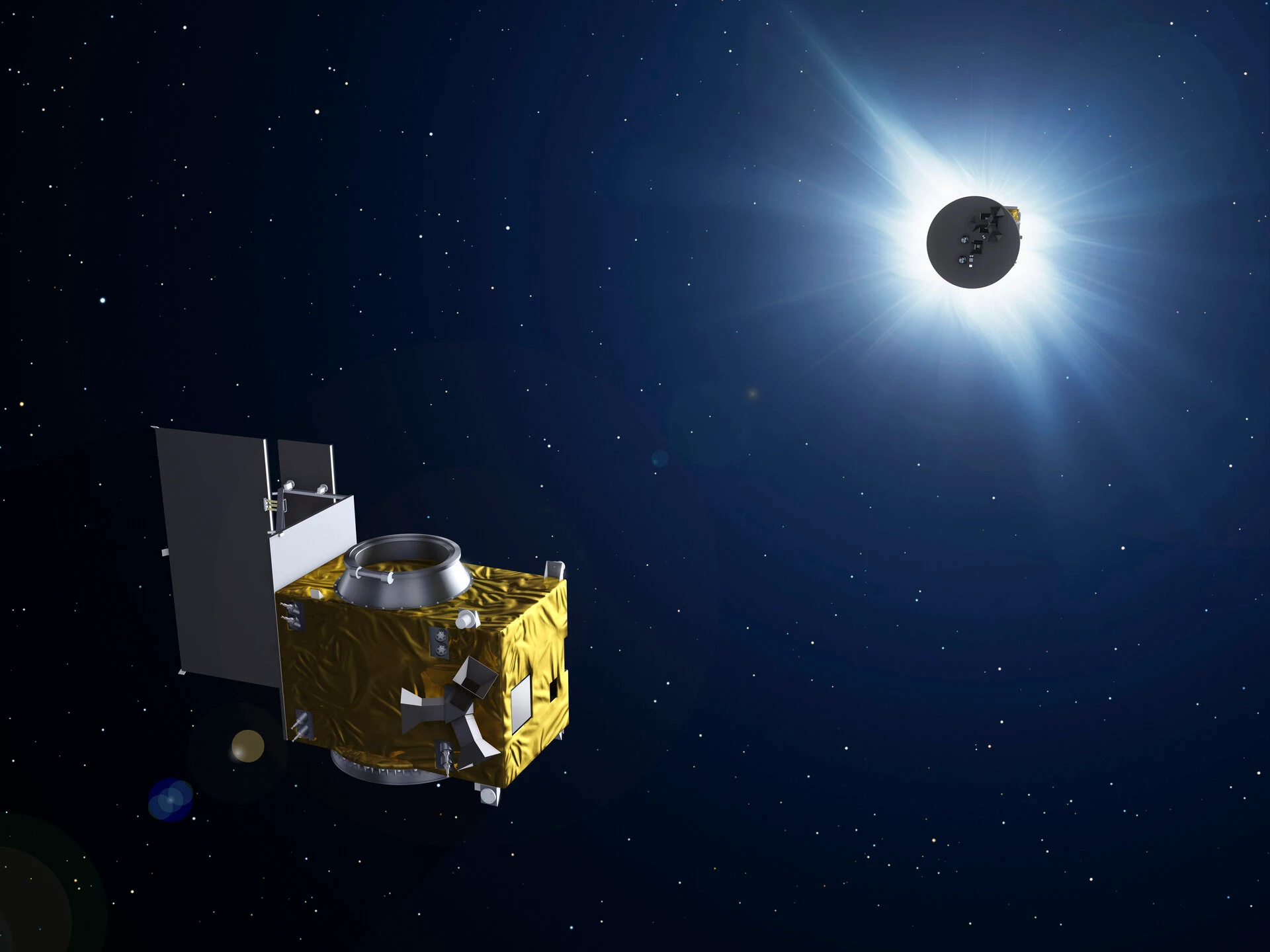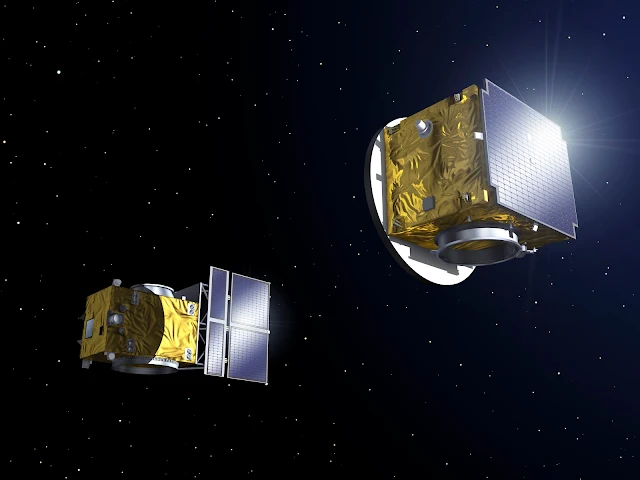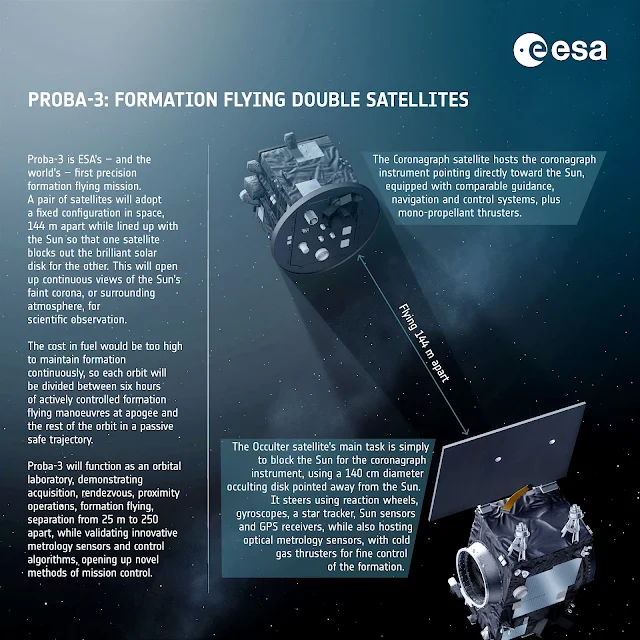
Following the recent Total Solar Eclipse, India's space agency, ISRO, is preparing to launch Europe's Proba-3 spacecraft. This mission aims to artificially create solar eclipses in space.
The mission will involve two small satellites that will launch together and then separate to fly in tandem. The goal is to prepare for future multi-satellite missions that fly as one virtual structure.
The Indian Space Research Organisation (ISRO) will launch the Proba-3 spacecraft. The mission will involve a pair of satellites that will fly together to form a 144-meter long solar coronagraph. The coronagraph will enable closer study of the Sun's corona, a mysterious layer usually only visible during solar eclipses.
Proba-3 is part of a series of PROBA satellites that are used to validate new spacecraft technologies and concepts while also carrying scientific instruments.
The purpose of Proba-3 is to conduct precision formation flying to create a solar coronagraph, enabling closer study of the Sun's corona.
Proba-3 will be the world’s first mission to conduct precision formation flying in space. A pair of satellites will not only fly together but also form a 144-meter-long solar coronagraph.
The Sun's corona, hotter than the Sun itself, is the origin of space weather. Proba-3 aims to bridge the observational gap between the low and high corona, offering insights into this enigmatic region. The corona is usually visible only during solar eclipses. Proba-3 will study it closer to the solar rim than ever before.
European Space Agency (ESA) has developed cutting-edge technologies for precise positioning and coordination of the spacecraft, including cold gas thrusters and vision-based detection systems, ensuring millimeter-scale accuracy.
ISRO's Polar Satellite Launch Vehicle (PSLV) will carry Proba-3 into a high Earth orbit from Satish Dhawan Space Centre. The launch date is yet to be finalized.
ESA's another spacecraft, Proba-2, captured two instances of the Total Solar Eclipse on April 8, providing valuable data from its Sun-synchronous orbit around 700 km above Earth's surface.
ISRO's collaboration with the European Space Agency (ESA) for the Proba-3 mission marks a significant step in space exploration. It offers new possibilities for studying the Sun's corona and advancing our understanding of solar phenomena.
How Proba-3 maintain its formation flying?
Proba-3, the world's first precision formation flying mission, demonstrates cutting-edge technologies for highly-precise satellite coordination. Proba-3's precision formation flying relies on coordinated maneuvers between the Coronagraph and Occulter, allowing unprecedented observations of the Sun's elusive corona.The goal of this mission is to prove formation flying technologies and conduct rendezvous experiments.
Coronagraph and Occulter
The Occulter spacecraft, equipped with a round disk, casts a shadow onto the Coronagraph spacecraft. By doing so, the Occulter blocks out the brilliant solar disk, allowing the Coronagraph to image the Sun's wispy outer atmosphere, known as its corona, for up to six hours at a time.
Ground and space observatories often incorporate Sun-blocking coronagraphs, but their effectiveness is limited by light spilling around disk edges, a phenomenon called diffraction. Proba-3's approach reduces diffraction by hosting the coronagraph on a separate spacecraft. The Occulter's edge has been precisely curved to further minimize diffraction effects.
While Proba-3 is primarily a technology-testing mission, its main payload is a science instrument focused on the Sun.
Once in orbit, the Occulter and Coronagraph satellites will autonomously perform precision formation flying, maintaining a distance of 150 meters apart, enabling six hours of observation per orbit.
Sustained observation of the corona will address mysteries such as why it is a million degrees Celsius hotter than the Sun's surface.
The ESA has collaborated with Belgium's Centre Spatial de Liège (CSL), and other European partners to ensure a successful mission.
Coronagraph and Occulter
 |
| Proba-3 Formation Flying |
Proba-3 consists of a pair of small satellites that fly together, maintaining a fixed configuration as a large rigid structure' in Space. The two satellites — the Coronagraph and the Occulter — work in tandem. During their orbits, they form a straight line in space with the Sun exactly 144 meters apart.
The Occulter spacecraft, equipped with a round disk, casts a shadow onto the Coronagraph spacecraft. By doing so, the Occulter blocks out the brilliant solar disk, allowing the Coronagraph to image the Sun's wispy outer atmosphere, known as its corona, for up to six hours at a time.
Ground and space observatories often incorporate Sun-blocking coronagraphs, but their effectiveness is limited by light spilling around disk edges, a phenomenon called diffraction. Proba-3's approach reduces diffraction by hosting the coronagraph on a separate spacecraft. The Occulter's edge has been precisely curved to further minimize diffraction effects.
While Proba-3 is primarily a technology-testing mission, its main payload is a science instrument focused on the Sun.
Once in orbit, the Occulter and Coronagraph satellites will autonomously perform precision formation flying, maintaining a distance of 150 meters apart, enabling six hours of observation per orbit.
Sustained observation of the corona will address mysteries such as why it is a million degrees Celsius hotter than the Sun's surface.
The ESA has collaborated with Belgium's Centre Spatial de Liège (CSL), and other European partners to ensure a successful mission.
 |
















 IndianWeb2.com is an independent digital media platform for business, entrepreneurship, science, technology, startups, gadgets and climate change news & reviews.
IndianWeb2.com is an independent digital media platform for business, entrepreneurship, science, technology, startups, gadgets and climate change news & reviews.



